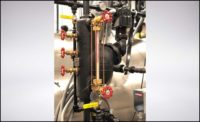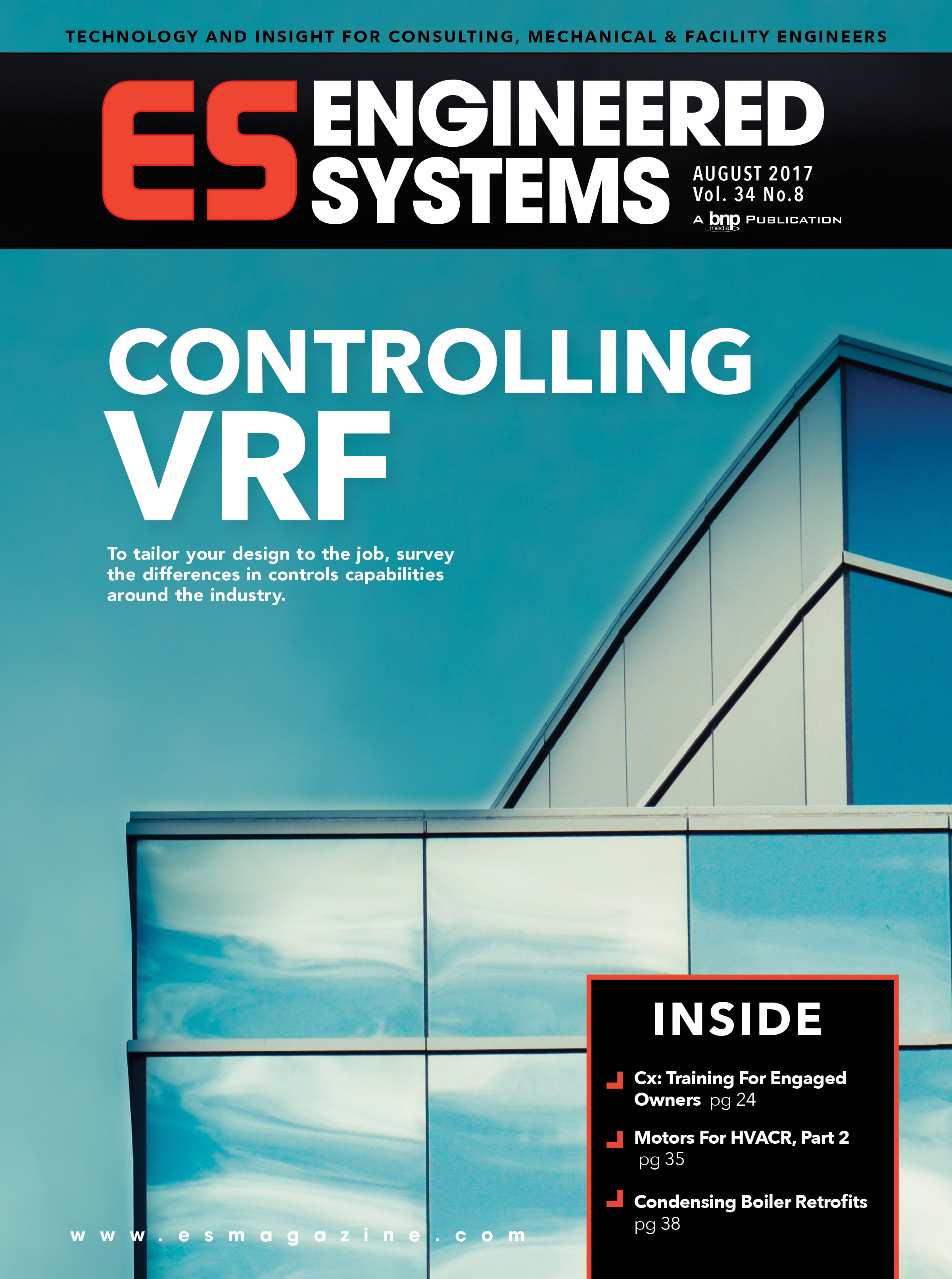CHILLER COMMISSIONING
The chiller commissioning process is, in many ways, all about verifying the operating parameters identified in the specifications. Some of these parameters can be measured directly (e.g., temperatures, pressures, flow rates, power consumption), while others are calculated (e.g., refrigeration capacity, efficiency).
Baseline readings and data obtained during the commissioning process should be recorded for future use. This can be either done manually or, preferably, recorded through the chiller’s control panel or BAS via a history print. Understanding how the chiller was performing when it was in as-new condition will provide a qualified technician with an optimal performance target throughout its life.
The other objectives of the commissioning process are identifying and correcting deficiencies in the system that could ultimately impact the reliability of the chiller and ensuring that the equipment is being operated in a safe manner. System deficiencies that could impact the reliability of a given piece of equipment include a water treatment program that is not in place or fully operational, as well as insufficient load that could cause the equipment to short cycle.
Before scheduling chiller commissioning, the technician who conducts the start-up should ensure all items on the manufacturer’s pre-commissioning checklist are complete. Initial cleaning/flushing of the piping system should be performed in a manner that does not allow the cleaning solution or debris to enter the heat exchanger bundles. Failure to keep contaminants away from the tube surfaces may lead to accelerated failure of the chiller tube bundles.
Commissioning provides a great kick-start to ensuring that a chiller will perform optimally throughout its life. As with all mechanical equipment, normal wear and tear will occur over time, and predictive and/or preventative maintenance must be performed on a regular basis to maintain chiller safety and performance. It is important to note that the parameters that were recorded at start-up were only a snapshot in time.
PERFORMANCE DATA TRENDING
These same parameters can and should be trended and used to evaluate the performance of a given machine over time. When problems are detected and subsequently corrected, chiller performance should approach the original baseline readings for a given load condition, assuming that no internal degradation and wear of components has occurred.
An analysis of operating data should focus on two main performance indicators: capacity (tons) and efficiency (kW/ton or the amount of energy that is being consumed to generate one ton of refrigeration).
In the ideal scenario, a chiller satisfies the cooling demand (tons) as efficiently as possible (low kW/ton). A qualified technician can evaluate how a unit is operating compared to its design tonnage and kW/ton and make recommendations that will return the chiller to new or close-to-new conditions. This evaluation typically identifies the following:
• Insufficient refrigerant charge, which leads to poor heat transfer performance in the evaporator and unreliable operation;
• Too much refrigerant, which can lead to refrigerant carryover into the compressor, inefficient operation, and possible damage to the compressor impeller and bearings;
• Poor heat transfer, due to tube (internal) and refrigerant side fouling in the evaporator and/or condenser bundles, which can lead to inefficient and possibly unreliable operation.
SEASONAL STARTUP
A seasonal startup provides a great opportunity to ensure that a chiller will operate reliably and efficiently throughout the upcoming cooling season. Even in warmer climates where traditional seasonal shutdown and startups are not performed, it is still beneficial to schedule a consistent time during each year of operation to validate that a machine is operating in an optimal fashion and make adjustments/corrections as needed.
Prior to performing a seasonal startup, it is important to verify that the chilled and condenser water valves are in their proper operating positions. Only then should the cooling tower and heat exchanger(s) be filled. In addition, water treatment must be in place and operational to minimize the potential of scaling and corrosion.
The technician should check the oil sump and/or compressor oil levels using the factory-installed sight glass(es) and, where applicable, be certain the oil return system is operating properly. Large-tonnage water cooled chillers use oil return systems to effectively return oil to the compressor so that a proper oil supply is present. If these systems fail to function properly, the chiller will shut down on one of its safety switches to prevent damage to the compressor.
On a related note, oil filters should be replaced per the manufacturer’s recommendations to ensure that particulate-free oil is being supplied at all times to the compressor. This, in turn, helps to ensure adequate lubrication of compressor bearings. It is also important to review the control panel for proper operation and check system pressures and temperatures to be certain the chiller is running in an optimal fashion.
Startup may also be an ideal time to conduct a vibration analysis. This analysis should be performed at least annually to ensure that both the compressor and motor are in good working condition. This procedure can identify an issue before a catastrophic failure occurs, avoiding downtime and repair costs.
The best time to conduct a vibration analysis is at full-load conditions. If adequate load is not available at startup, it is important to return and perform this test when the chiller is operating at full load. In any case, the results of the analysis can be compared with earlier baseline results. If baseline readings were never gathered, it is never too late to start this valuable procedure. It is also important to note that trending these and other test results helps identify changes over time that may indicate problems that require corrective actions.
Finally, be certain that a proper load is present on a chiller during seasonal startups. Although it may be difficult to predict what the weather will be at startup or the size of the load on the building, it is important that a proper load is present to more accurately validate chiller performance.
IMPORTANCE OF CHILLER SHUTDOWNS
It is difficult to talk about chiller startups without discussing chiller shutdowns, because the successful startup assumes the chiller was shut down properly and in a controlled manner. The shutdown process begins with a review of the control panel functions for proper operation and evaluation of recorded fault histories. During shutdown, maintenance and repairs should be performed on system components such as cooling towers, pumps, valves, etc. The goal is to be certain the chiller and system are functioning well prior to shutdown and identify deficiencies that can be addressed during the shutdown period. This ensures that the machine will be ready to start as soon as it is required.
This is also the time to verify proper operation of the oil or crankcase heater(s). These heaters must be energized for a given time period prior to startup to make sure that the refrigerant is separated from the oil. They are designed to boil off the refrigerant that has been absorbed by the oil during the off cycle.
Oil and refrigerant analysis will help identify issues with oil viscosity, moisture, and acid in the refrigerant. These analyses should be trended over time and action taken as required.
Water bundles should be isolated and drained as part of the shutdown procedure. Once draining is complete, the water side of the bundles should be checked (using a refrigerant leak detector) to make certain that no leaks are present in the tubes.
At the same time, a thorough leak check of the chiller should be conducted. All identified leaks should be repaired immediately to prevent refrigerant loss during shutdown. For those chillers that are subjected to subfreezing temperatures, winterization of the heat exchanger bundle(s) may be required to prevent freeze damage.
In addition, the technician should oil and/or grease moving parts, as recommended by the manufacturer, and tighten all electrical connections. Failure to address loose connections can lead to overheating of components and subsequent premature failure.
Finally, the shutdown procedure should include cleaning the heat exchangers and condenser coils. Water boxes should be removed and the tubes brush cleaned. After cleaning, bundles need to be dried to prevent corrosion during the storage period and the water boxes reinstalled. If completely drying the bundle is not an option, corrosion inhibitors are available that are specifically designed to provide adequate corrosion protection.
An eddy current test should be performed (where applicable) prior to reinstalling the water boxes to ensure that no corrosion/tube wear is present that could compromise the reliability of the unit. This is particularly important. In fact, this is a good time to examine all equipment and identify any signs of corrosion, oil leaks, etc., and take the appropriate action to correct or prevent similar issues in the future.
Condenser coils (air cooled equipment) should be washed in a manner that will not cause fin damage (refer to specific manufacturer instructions for details). Then, tag the chiller as out-of-service and take an inventory of emergency spare parts, replenishing them as necessary.
In situations where a chiller runs year-round and does not go through the shutdown/startup process, facility managers should follow the recommended maintenance procedures identified by the equipment manufacturer. Doing so minimizes the risk of a catastrophic failure, extends the life of the equipment, ensures its efficient operation, and reduces the cost of future repairs. It is important to note that different chiller types have different manufacturer recommendations; with some tasks being performed three or more times a year and others annually.
PARTNERING WITH THE RIGHT TECHNICIAN
In every case, maintenance procedures, as well as shutdown and startup procedures, should be performed by a qualified technician wearing protective equipment. After all, HVAC equipment is inherently dangerous and brings with it the potential for personal injury due to moving parts, the potential for electrical shock, and exposure to high refrigerant pressures associated with the equipment.
In selecting a technician, be certain to choose someone who is experienced in servicing the type of chiller in your facility. Most original equipment manufacturers employ highly trained professionals that have the skills and tools to perform the work. A qualified technician from a large service network also offers access to an even larger array of resources, including technical literature, service bulletins and, in some cases, a technical support group that fully understands how to get the most from a particular piece of equipment. These resources will ensure that appropriate recommendations are provided as quickly as possible.
Using the services of a qualified technician to perform the procedures outlined in this article delivers several important benefits, including improved chiller performance and reliability, minimized downtime, potential energy savings of 30% or more, maximum equipment life, minimal repair and service costs, and a greater return on capital equipment investment.
In addition, a trained technician who is familiar with the chiller can use a chiller startup to make recommendations that will reduce energy costs and improve plant operation. For example, a qualified technician might recommend dropping the chiller’s entering condenser water temperature to the minimum allowed by a given manufacturer. This simple step will improve chiller efficiency and, in some cases, may increase the unit’s cooling capacity.
Where plants include multiple chillers, a technician might recommend changing the sequencing of the units, so that they operate in a more efficient and reliable manner. In the case of an oversized chiller, recommendations can also be made to modify a unit and/or its control settings to help optimize its operation at light load conditions.
Seasonal chiller startups bring opportunities to improve chiller plant performance, operational efficiencies, energy savings, and occupant comfort. However, in most cases, these benefits are fully realized only when the startup is part of a comprehensive program that includes commissioning, proper seasonal shutdown procedures, and a regular maintenance pr






